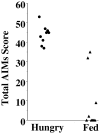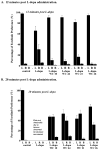Evaluation of D2 and D3 dopamine receptor selective compounds on L-dopa-dependent abnormal involuntary movements in rats
- PMID: 19371586
- PMCID: PMC4106465
- DOI: 10.1016/j.neuropharm.2009.01.019
Evaluation of D2 and D3 dopamine receptor selective compounds on L-dopa-dependent abnormal involuntary movements in rats
Abstract
A panel of novel D2 and D3 dopamine receptor selective antagonists, partial agonists and full agonists have been evaluated for the ability to attenuate L-dopa-associated abnormal involuntary movements (AIMs) in 6-hydroxydopamine (6-OHDA) unilaterally lesioned male Sprague Dawley rats, which is an animal model of L-dopa-induced dyskinesia (LID). LID is often observed in patients with Parkinson's Disease following chronic treatment with L-dopa. The intrinsic activity of these dopaminergic compounds was determined using a forskolin-dependent adenylyl cyclase inhibition assay with transfected HEK 293 cells expressing either the human D2Long or D3 dopamine receptor subtype. For the initial experiments the 5-HT1A receptor selective partial agonist buspirone was used to verify our ability to quantitate changes in total AIMs and AIMs minus locomotor scores. Two D2 dopamine receptor selective antagonists, SV 156 and SV 293, were evaluated and found to minimally attenuate AIM scores in these animals. Four members of our WC series of D3 dopamine receptor selective compounds of varying intrinsic activity at the D3 dopamine receptor subtype, WC 10, WC 21, WC 26 and WC 44, were also evaluated and found to attenuate AIM scores in a dose dependent manner. The in vivo efficacy of the compounds increased when they were administered simultaneously with L-dopa, as compared to when the compounds were administered 60 min prior to the L-dopa/benserazide. It was also found that the D3 receptor antagonist WC 10 could inhibit the involuntary movements after they had achieved maximum intensity. Unlike the D1-like dopamine receptor selective agonist SKF 81297 and the D2-like dopamine receptor agonist bromocriptine which can precipitate abnormal involuntary movements in these unilaterally lesioned animals, abnormal involuntary movements were not observed after administration of our D3 receptor selective agonist WC 44. In addition, we evaluated the effect of these four D3 dopamine receptor selective compounds for their effect on a) spontaneous locomotion and b) coordination and agility using a rotarod apparatus. We also used a cylinder test to assess the effect of L-dopa on spontaneous and independent use of each of the rat's forelimbs in the presence or absence of test compound. The results of these studies suggest that substituted phenylpiperazine D3 dopamine receptor selective compounds are potential pharmacotherapeutic agents for the treatment of L-dopa-associated dyskinesia in patients with Parkinson's Disease.
Figures
















Similar articles
-
Evaluation of the D3 dopamine receptor selective antagonist PG01037 on L-dopa-dependent abnormal involuntary movements in rats.Neuropharmacology. 2009 May-Jun;56(6-7):944-55. doi: 10.1016/j.neuropharm.2009.01.020. Epub 2009 Feb 5. Neuropharmacology. 2009. PMID: 19371585 Free PMC article.
-
Evaluation of the D3 dopamine receptor selective agonist/partial agonist PG01042 on L-dopa dependent animal involuntary movements in rats.Neuropharmacology. 2011 Feb-Mar;60(2-3):284-94. doi: 10.1016/j.neuropharm.2010.09.011. Epub 2010 Sep 17. Neuropharmacology. 2011. PMID: 20850462 Free PMC article.
-
The 5-alpha reductase inhibitor finasteride reduces dyskinesia in a rat model of Parkinson's disease.Exp Neurol. 2017 May;291:1-7. doi: 10.1016/j.expneurol.2017.01.012. Epub 2017 Jan 26. Exp Neurol. 2017. PMID: 28131725
-
Pathogenesis of levodopa-induced dyskinesia: focus on D1 and D3 dopamine receptors.Parkinsonism Relat Disord. 2005 Jun;11 Suppl 1:S25-9. doi: 10.1016/j.parkreldis.2004.11.005. Parkinsonism Relat Disord. 2005. PMID: 15885624 Review.
-
Advances and challenges in the search for D2 and D3 dopamine receptor-selective compounds.Cell Signal. 2018 Jan;41:75-81. doi: 10.1016/j.cellsig.2017.07.003. Epub 2017 Jul 14. Cell Signal. 2018. PMID: 28716664 Free PMC article. Review.
Cited by
-
Pharmacological targeting of G protein-coupled receptor heteromers.Pharmacol Res. 2022 Nov;185:106476. doi: 10.1016/j.phrs.2022.106476. Epub 2022 Sep 28. Pharmacol Res. 2022. PMID: 36182040 Free PMC article.
-
Sustained increase of PKA activity in the postcommissural putamen of dyskinetic monkeys.Mol Neurobiol. 2014 Dec;50(3):1131-41. doi: 10.1007/s12035-014-8688-7. Epub 2014 Apr 5. Mol Neurobiol. 2014. PMID: 24705818
-
Phenylpiperazine derivatives with selectivity for dopamine D3 receptors modulate cocaine self-administration in rats.Neuropharmacology. 2012 Dec;63(8):1346-59. doi: 10.1016/j.neuropharm.2012.08.011. Epub 2012 Aug 31. Neuropharmacology. 2012. PMID: 22960444 Free PMC article.
-
Neurobiological and Pharmacological Perspectives of D3 Receptors in Parkinson's Disease.Biomolecules. 2022 Feb 1;12(2):243. doi: 10.3390/biom12020243. Biomolecules. 2022. PMID: 35204744 Free PMC article. Review.
-
Striatal D1 medium spiny neuron activation induces dyskinesias in parkinsonian mice.Mov Disord. 2017 Apr;32(4):538-548. doi: 10.1002/mds.26955. Epub 2017 Mar 3. Mov Disord. 2017. PMID: 28256010 Free PMC article.
References
-
- Asghari V, Sanyal S, Buchwaldt S, Paterson A, Jovanovic V, Van Tol HH. Modulation of intracellular cyclic AMP levels by different human dopamine D4 receptor variants. J Neurochemistry. 1995;65:1157–1165. - PubMed
-
- Bézard E, Ferry S, Mach U, Stark H, Leriche L, Boraud T, Gross C, Sokoloff P. Attenuation of levodopa-induced dyskinesia by normalizing dopamine D3 receptor function. Nature Medicine. 2003;9:762–767. - PubMed
-
- Bézard E, Brotchie JM, Gross CE. Pathophysiology of levodopa-induced dyskinesia: Potential for new therapies. Nature Reviews/Neuroscience. 2001;2:577–588. - PubMed
-
- Bibbiani F, Costantini LC, Patel R, Chase TN. Continuous dopaminergic stimulation reduces risk of motor complications in parkinsonian primates. Experimental Neurology. 2005;192:73–78. - PubMed
-
- Bibbiani F, Oh JD, Chase TN. Serotonin 5-HT1A agonist improves motor complications in rodent and primate parkinsonian models. Neurology. 2001;57:1829–1834. - PubMed
Publication types
MeSH terms
Substances
Grants and funding
LinkOut - more resources
Full Text Sources
Miscellaneous

